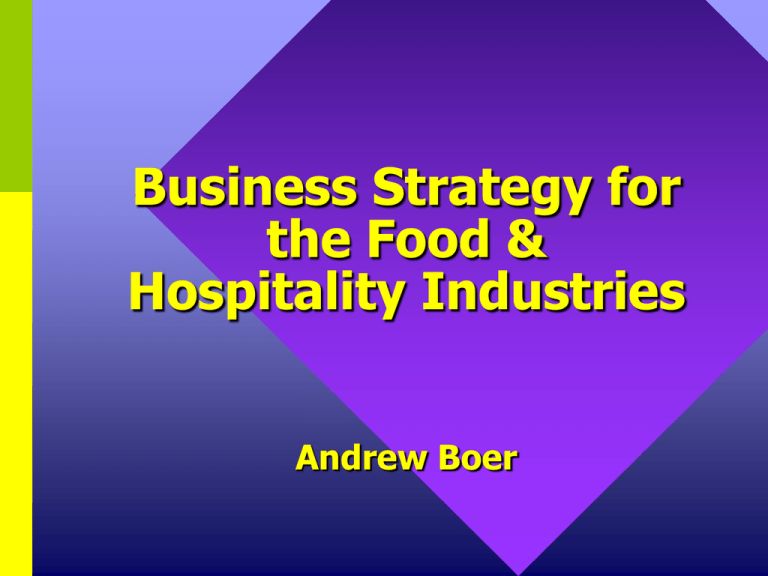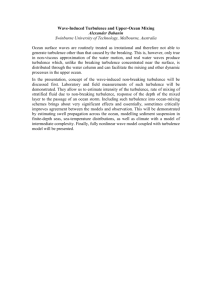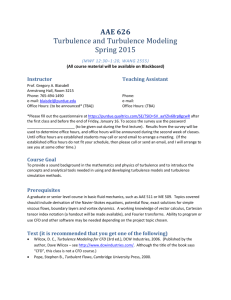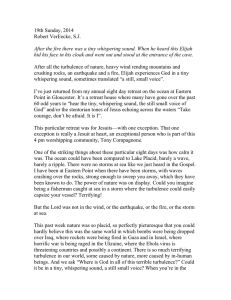Business Strategy for the Food & Hospitality Industries Andrew Boer
advertisement

Business Strategy for the Food & Hospitality Industries Andrew Boer Analytical Tools Workshop • Covered: – Market / customer analysis – Competitive analysis – Financial analysis – Portfolio analysis – Resource analysis – Operational analysis – Strategic group analysis etc…….. Analytical Tools Workshop • Tools are often ineffective when used in isolation / individually • Tools do not always need to be 100% accurate (higher % the better, but no need to ensure 100%) • Tools can be interpreted in different ways by different people Analytical Tools Workshop • Application of tools also varies, even given the same criteria…hence no such thing as a ‘right’ answer • Complexity of tools and texts : often better to utilise simple solutions • Tools of analysis not only there to develop insight and analysis but also as tools of communication Analysis of the Business Environment • The Remote Environment – those issues which may affect the operating environment but which the business cannot significantly influence • The Operating Environment – the environment and factors which most immediately concern the business (ie those issues which have impact on the business, its markets and direct competitors) Analysis of the Business Environment • PEST / PESTE analysis • Critique of PEST / PESTE – Limited in scope & parameters due to the recognition of an increasingly diverse environment and the increased likelihood of environmental issues impinging on the organisation (e.g IT ; Globalisation etc) Demographics Economic Ecological Political The Enterprise Legal Information Socio cultural Technological Examples of environmental influences : DEEPLIST Analysis of the Business Environment • DEEPLIST Critique – Perspective dependent on the ‘timeframes’ in which the organisation is working. – ‘Miscategorisation’ of interrelated factors which could be included under more than one heading – May only be indicative of ‘effects’ not ‘causes’ – Not an exhausive / finite listing of categories and may lead to focus on wrong issues – Only as good as the people compiling it ! – Simplistic ? Too detailed ? DEEPLIST Analysis • Demographic – Characteristics of human populations • Economic – Structural shifts in economies as well as the nature of economic activity (GDP; taxation; inflation; exchange rates; consumption levels etc) • Ecological – Consequences of environmental change DEEPLIST Analysis • Political – Policies of governments regarding the infrastructure and trade environment • Legal – Policies regarding the legislative infrastructure and environment • Informational – Nature and availability of new sources and types of information DEEPLIST Analysis • Social / Sociological / Sociocultural – Characteristics reflecting lifestyles and social expectations and aspirations • Technological – Impact of technological change on the production process, the customer or the nature of the products or services Predictive Models • Need to consider the dynamics and turbulence of the environment to put predictive models into context. • Changeability – Degree to which the market is likely to change • Predicatbility – Degree with which such changes can be predicted Environmental Dynamics and Turbulence Low High Changeability Changeability Low Predictability Responsive Environment High Predictability Low Turbulence Environment High Turbulence Environment Proactive Environment Predictive Models • If turbulence is low may be possible to predict the future with confidence (Prescriptive strategies?) • If turbulence is high, the future is more difficult to predict and the organisation needs to be structured to reflect this (Emergent strategies?) Predictive Models • In a reflexive environment, the organisation will need to ensure it has flexibility of both resources and systems • In a proactive environment, the organisation can develop an infrastructure to support continuous development • BUT..can you really tell the future??











